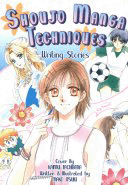
One of the things that fans of shoujo manga repeatedly state is the type of stories that are told connects on a deep level to them. I’ve heard people state that there is a realism even in the most whacked out situations, that there is a core of truth that makes them empathies with the character. It is said that good writing, in all forms, reflects from the heart and simply expresses an emotion honestly and truthfully wherever it may go. The trick to this feeling in manga is not some cultural blessing that only the Japanese possess, but one that is easy to learn and involves connecting with your own heart. “Shoujo Manga Techniques: Writing Stories” by Kaimu Tachibana and Maiko Itsuki leads the way.
The story is told Edu-manga style, centering on young Alisa Mizuki, an eager but very confused girl who wants to create a manga. Alisa’s a bit intimidated by all the great manga around her, so her older friend Kyoko Nakasato shows her the ropes on how to go from concept, to characters, to page pacing and layout. As the story progresses, Alisa and Kyoko tackle a different concept and step in creating a manga. Along the way, Alisa makes some truly bone-headed blunders that help highlight some of the problems a beginner artist must face. With Kyoko’s help, Alisa learns to lessen her frustration at creating a story and keeping each step together.
One example is finding out the theme of the manga. The theme is an idea that ties the whole story together. A theme can be something like “I want to draw a girl who falls in love and blunders all the time”. Since everything in the story will reference this event, this makes it easier to come up with ideas and prevent a story from going off track. In choosing a theme, Kyoko recommends looking at your bookshelf to see what stories you find most interesting. More than likely, what you will want to write is already there, as you will have been attracted to it already. Another example is ideas, which work with the theme. Whereas the theme helps express your overall point to the story, ideas in this case help to expand on that thought. So if the story of the blundering girl takes place in a cake shop, to get more ideas, you list everything that comes to mind that comes to mind from that setting, then from that list find things that associate with those items. For example, a cake shop has a waitress, so the main character may be a waitress. By making the character related mentally to the concept of the cake shop, there stands less of a chance of the story going off track and helps create a tighter feel without many loose ends to tie up later.
The only drawback to the book is that it will take time to go through the concepts and absorb them properly. Even though Alisa and Kyoko explain a concept thoroughly yet understandably, these are still a form of literary concepts, not an easy subject to tackle. If you are using this book for first aid on your own stories and want to skip ahead, you still might want to read from the beginning, as Kyoko references concepts that have gone before with only a slight review. However, these are nothing compared to the overall richness of the book; there are very few books on writing stories, much less creating comics, that explains these concepts simply with no problems. This is a much needed book in English, regardless of if you are writing shoujo stories, manga, or even comics.
Over and over again, Kyoko stresses that you must feel something for what you are writing, that it must be drawn from your own experiences and be something dear to you along with making it readable and understandable to your audience. All too often people choose subjects because they will be “popular” but when dealing with something as complicated and creative as writing a story, starting from a false place will create a lackluster product, regardless of how popular it is…a product with no emotions, and one whose characters seem to have no heart either. And as readers of shoujo manga will tell you, the heart is what attracted them to the genre in the first place.
Love it, hate it, buy it!






